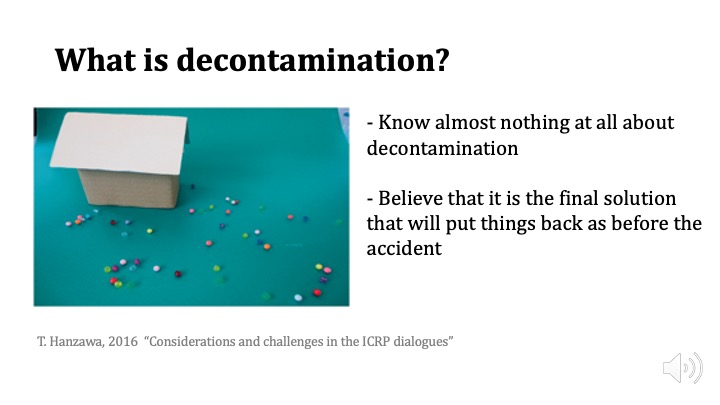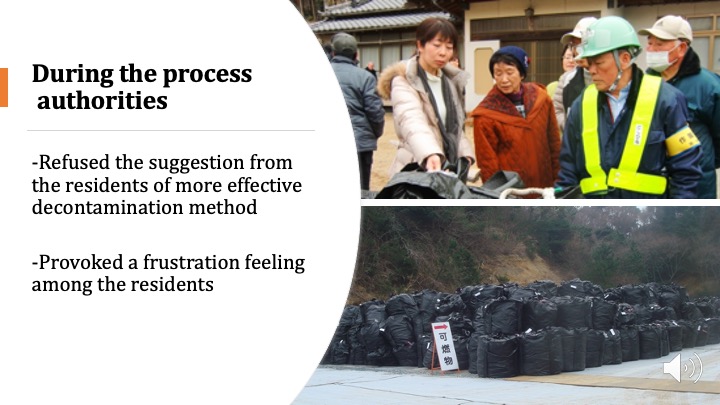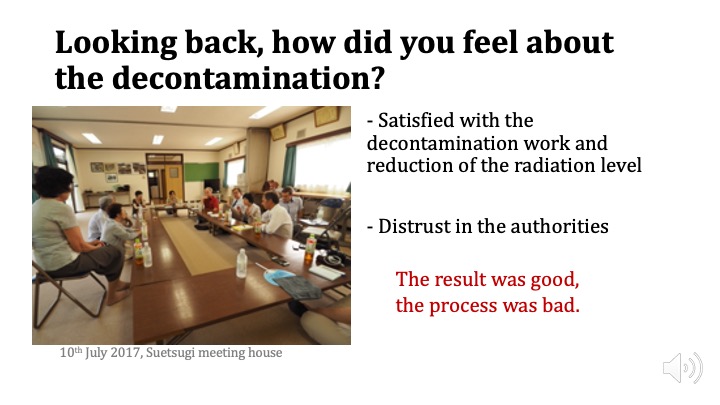This is the PPT material and text presented by Ms Ando, the director of our organisation, at the Remplex: 2021 Global Summit on Environmental Remediation hosted by the Pacific Northwest National Laboratory in cooperation with the IAEA.


Hello everyone, my name is Ryoko Ando from NPO Fukushima Dialogue.
I will start today’s presentation by introducing myself.
I was born and raised in Hiroshima. I went to university and studied comparative culture.
I started to live in Fukushima in 2003 when I married my husband who is from Minamisoma, Fukushima.
Before the Fukushima accident, I was not interested at all in nuclear energy and radiation protection. It is only after the accident that my experience in radiation risk communication began.

I have been involved in two main activities since the Fukushima accident.
The first is to participate in the ICRP Dialogue bringing together stakeholders from inside and outside of Fukushima. It has been held 22 times so far. In 2020, ICRP’s official involvement ended, and now the NPO Fukushima Dialogue, of which I am the president, is running the event.
The other is the radiation measurement activities in the small community of Suetsugu in Hisanohama, Iwaki City, Fukushima Prefecture where, together with local residents I worked for nine years from 2012 to 2020 to help them recover their lives.We have written articles about both experiences. If you are interested, please have a look.

Today, the previous Japanese presenter gave a presentation on decontamination. I would like to speak from the perspective of what decontamination has been like for the residents. Through my work with Dialogue and in the Suetsugu area, I have had the opportunity to hear many stories about decontamination because it was a serious concern for the residents of the affected areas in Fukushima Prefecture after the accident.
Before we talk about decontamination, allow me to give you some background on the residents’ situation after the accident.
First of all, very few people had any knowledge of radiation. If they did, their knowledge was very fragmentary. The amount of knowledge and the sense of risk varied greatly from person to person. There was hardly a common understanding of radiation that people could share. There was also a lot of resentment and distrust of the Japanese Government and TEPCO for what had happened.
For years, the Japanese Government and TEPCO kept explaining that an accident could not occur. There was also a strong distrust of the scientists and experts who had developed and supported nuclear technology.
For the residents, their lives were severely disrupted by an accident they never expected. Although it was not their choice, they have been changed their way of life. As a result, there was a very strong feeling among the residents that things were going back as they were before the accident.
“We want things to go back as they were before the accident.” I have heard these words very often…

This was where “decontamination” came in.
The fact is that most people know as little about decontamination as they do about radioactivity. They didn’t know what it was, but they were under the impression that decontamination was the definitive solution to get rid of radiation and get life back as they were before the accident.
Look at the pictures.The beads represent radioactive material, and the objective is to collect them and store them in boxes. This is how the person in charge of decontamination in Date City explained to residents what was going to be done because they did not understand what the decontamination was for.

It sould be noted that it was exceptional for the authorities to give such a clear explanation. Please see the next picture. This is a briefing in 2011 in the Suetsugu district of Iwaki City. Males sitting in front are representatives of the authorities. It was a one-way briefing, with a document prepared in advance being distributed and read out loud.
A resident asked,” to what extent can you reduce radiation by decontamination? He was told that the Government of Japan set in the standard of 0.23 μSv/h for deciding areas to be decontaminated.
However, due to the complete lack of understanding of radiation, 0.23 was perceived by the residents to be a safe standard for radiation. The resident asked the authorities to promise that decontamination would bring the level down to 0.23 or lower.
In fact, at that time, the government officials were also confused. On the one hand, some of them didn’t understand what the 0.23 standard meant.
On the other hand, others promised the residents that they would lower the level of contamination below 0.23.This is how the 0,23 value became a border between safety and danger for the residents and also a “promise” from the administration.

Now, the decontamination process has begun.
In this process, the residents have come to know what the decontamination was concretely, like cutting down trees, stripping the soil, washing the walls and so on.
A private construction company undertook the decontamination work. In areas where people live, a person in charge explained the work results to the residents.
Having the situation explained directly meant a lot to some of the residents. They were able to understand the situation better and felt that they had been treated appropriately.

On the other hand, some of those who had not benefited from the decontamination as expected were not happy.
Since it was a public project, the authorities said that the response had to be the same for everyone.
Therefore, it was common for the authorities to reject the residents’ suggestions for a more effective and rational decontamination. This led to a strong sense of frustration among the residents, who felt that the authorities did not take appropriate action.

Several years after the decontamination was finished, we asked some residents what they thought of the decontamination.
Many people were satisfied with the fact that the decontamination had reduced radiation levels. They were also happy that the decontamination had been carried out. But on the other hand, they were very dissatisfied with the process.
Many of them strongly complained that their opinions were not listened to at all. They also complained that the authorities sometimes could not get the leval down to 0.23 as promised. When we asked them if their trust in the authorities had increased, they said that it had not increased at all.
Several years after the accident, most residents knew that 0.23 was by no means an indicator of safety and danger. But nevertheless residents were satisfied with the decontamination work.
Despite these facts, the residents had even less confidence in the administration. The main reason for this was that their opinions were not listened to in the decision-making process. Thus the issue had became one of the decision-making processes, and not just of risk.

There are still areas in Fukushima Prefecture where the evacuation order is not expected to be lifted in the near future. These areas have not yet been decontaminated. In areas with high radiation doses, decontamination may not bring down radiation levels sufficiently.
The Japanese Government said that budgetary constraints make further decontamination difficult. Residents in these areas are calling for decontamination. They say. “We’ve been waiting for ten years. Why can’t you just do it for us?” and “You have polluted our property, so it is only right that you should clean it up and return it to us”.
This means that in addition to risk and the decision-making process, the ethical issues of “fairness”, “equity” and “responsibility” have become serious problems.

After finishing the decontamination work, there was another big problem. It is the issue of waste.
The waste has been taken to an intermediate storage facility built in the evacuation zone around the nuclear plant.
The law requires that this waste to be transported out of Fukushima Prefecture after 30 years.
However, there is no decided final destination for the waste. Everyone in the affected areas knows this, and few believe the Government’s promise will be kept.

Now, let’s take a look back at the ten years of decontamination work.
First, a risk event occurred. So, the first question was about risk: Is it safe or dangerous? That was the main focus. Decontamination was carried out to reduce the risk.
Then, a new problem was added in the decontamination process: the administrative response to the decision-making process. The dissatisfaction and distrust of the administration that arose from these problems have remained over time.
As the decontamination work progressed, the inevitable problem of waste arose. Again, the Government made empty promises. Many people believe that a government that has never listened to them and only made decisions unilaterally will not keep its promises in the future.
There is a strong sense of unfairness in the evacuation areas that have not been decontaminated. Now, the residents of the evacuation zone are insistently demanding decontamination. It is become an ethical issue in our society which is far removed from the original goal of decontamination, which was to reduce the risk.What started out as a matter of risk has, over time, become a matter of grievance against the authorities, and now it is an ethicalquestion. Each new problem became more complex as it arose, mixed with the previous ones.

If it is only a risk problem, we can deal with it by reducing the risk. If it is only a question of procedure, we can improve the situation by improving the procedure.
But ethical issues are a different matter. When we have an ethical confrontation, we have usually experienced an emotional conflict before. Emotional confrontations have a profound effect on our minds and remain firmly in our memories.
Negative emotions such as distrust, resentment, and hopelessness can seriously affect the next step in the process.
It is difficult for anyone to resolve ethical conflicts caused by the emotional confrontation in the previous steps in a short time.
It is desirable to take ethical aspects into account to avoid these situations before a problem arises.
Considering the ethical dimension beforehand make it possible to handle another issue like reducing risk and improving procedure without unnecessary friction.

How to communicate effectively on risks?
In the case of Fukushima, the situation got complex as time passed. One of these reasons is that we lacked the views of the ethical aspect. If we had taken care of the ethical aspect from the beginning of the process, the current situation would be much better.
From our experience, we can say the following things.
I think the most important thing is to build trust.
If you don’t have trust, then even if you achieve your initial goal, as in the case of the decontamination process in Japan, you will face one problem after another, and gradually you will be in front of a bigger problem with no solution.
But the next question is how do we build trust?
It is essential to include stakeholders in the decision-making process from the very beginning. If the authorities decide unilaterally, they may let some time pass, but inevitably this will result in a strong and deep-rooted sense of mistrust.
What matters is to give a clear picture of the real situation. It is vital to have ongoing discussions with stakeholders to distinguish, as far as possible, between what is a risk issue, what is an administrative procedure issue and what is an ethical issue.
It is also essential to have a time horizon of the following steps and what the future holds. No one can trust a plan or action if they don’t know what the future holds. There is no only definitive solution to respond to a risk event. Things can sometimes go wrong. When there are mistakes, the ability of people to accept the consequences depends on the reliability of the process.. That’s why it’s so important that the process is transparent and fair.

Now, finally, let me advertise our activity.
We are organising a meeting to discuss the ALPS treated water at Fukushima Daiichi that TEPCO will release into the sea on the 28th of November. Simultaneous translation will be provided, and we will stream the event via Zoom. A recording will be available later on the website. This is an excellent opportunity to see what the issues are at Fukushima at the moment.
We look forward to seeing you there!
We organised the 23rd Dialogue on 28th Nov. 2021. All materials are available at the link below.
https://fukushima-dialogue.jp/bk/202111_dialogue_record.html
